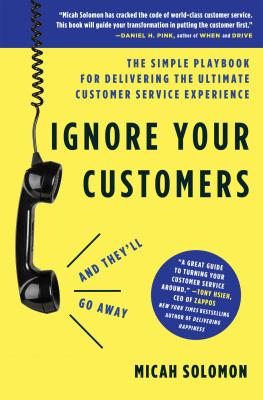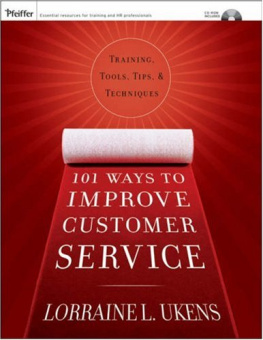
SERVICE FAILURE
The Real Reasons Employees Struggle with Customer Service and What You Can Do About It
Jeff Toister

AMERICAN MANAGEMENT ASSOCIATION
New York Atlanta Brussels Chicago Mexico City San Francisco
Shanghai Tokyo Toronto Washington, D.C.
Bulk discounts available. For details visit:
www.amacombooks.org/go/specialsales
Or contact special sales:
Phone: 800-250-5308
E-mail:
View all the AMACOM titles at: www.amacombooks.org
This publication is designed to provide accurate and authoritative information in regard to the subject matter covered. It is sold with the understanding that the publisher is not engaged in rendering legal, accounting, or other professional service. If legal advice or other expert assistance is required, the services of a competent professional person should be sought.
Library of Congress Cataloging-in-Publication Data
Toister, Jeff.
Service failure : the real reasons employees struggle with customer service and what you can do about it / Jeff Toister.
p. cm.
Includes index.
ISBN 978-0-8144-3199-3 ISBN 0-8144-3199-2 1. Customer services. 2. Customer relations. 3. EmployeesTraining of. I. Title.
HF5415.5.T65 2013
658.812dc23
2012021284
2013 Jeff Toister.
All rights reserved.
Printed in the United States of America.
This publication may not be reproduced, stored in a retrieval system, or transmitted in whole or in part, in any form or by any means, electronic, mechanical, photocopying, recording, or otherwise, without the prior written permission of AMACOM, a division of American Management Association, 1601 Broadway, New York, NY 10019.
The scanning, uploading, or distribution of this book via the Internet or any other means without the express permission of the publisher is illegal and punishable by law. Please purchase only authorized electronic editions of this work and do not participate in or encourage piracy of copyrighted materials, electronically or otherwise. Your support of the authors rights is appreciated.
About AMA
American Management Association (www.amanet.org) is a world leader in talent development, advancing the skills of individuals to drive business success. Our mission is to support the goals of individuals and organizations through a complete range of products and services, including classroom and virtual seminars, webcasts, webinars, podcasts, conferences, corporate and government solutions, business books, and research. AMAs approach to improving performance combines experiential learninglearning through doingwith opportunities for ongoing professional growth at every step of ones career journey.
Printing Number
10 9 8 7 6 5 4 3 2 1
CONTENTS
Acknowledgments
I am indebted to many fantastic people who helped make Service Failure possible. At the very top of the list is my wife, Sally, whose unwavering support and encouragement continuously inspires me, while her sharp business mind makes her my most trusted colleague.
Many thanks go to a number of people who were instrumental in helping me turn a mountain of research and ideas into a book. Grace Judson, my initial editor, helped me clarify my voice as an author and used her keen eye to make my writing much more readable. My agent, Maryann Karinch, used her experience and wisdom to give me a great sense of optimism about the unknown while giving me a crash course on how to become an author. I also appreciate the kindness and patience of Robert Nirkind, my editor at AMACOM Books, whose guidance helped Service Failure become a much better book than it would have been without him.
A special note of appreciation is due to my friend Lori Roth. Her enthusiasm for this project and her amazing professional network were the catalyst that led me to AMACOM Books.
I also appreciate the many customer service professionals who generously shared their experiences with me so I could use their first-hand accounts to provide real challenges and proven solutions to overcoming these obstacles.
Finally, Id like to thank all of the companies whose employees continuously provide terrible customer service. Without them, I wouldnt have anything to write about.
Introduction
T he man walked into a clothing store and spent a few minutes searching for khaki pants, without any luck. He finally spotted an employee and approached him to ask for assistance. Excuse me, he said. Do you carry Dockers?
The sales associate, looking like a deer caught in the headlights, gazed around the immediate area and then stammered, I dont know.
You dont know, huh? the customer responded, walking out of the store without waiting for a reply.
Does this story sound familiar? We all experience poor customer service far too often. Many employees dont seem to care about helping their customers. Even those who do make an effort frequently miss obvious opportunities to provide better service.
Its easy to think of customer service as being a matter of common sense. The sales associate clearly should have known more about the products the store was selling. And if he encountered a question he couldnt answer, he should have found another employee who could provide a knowledgeable response. Instead, he did neither, and the customer walked out the door, the store having lost out on whatever money the customer had intended to spend.
This leads to an important question: Why didnt the sales associate provide better customer service? To learn the answer, you would need to know the employees version of the story.
It was the sales associates first day on the job. He was sixteen and had never worked before, so he was nervous. His supervisor had given him a brief tour of the mens department, where he would be working that day, before leaving him alone as she went on her fifteen-minute break. The sales associate had no training, no experience, and hadnt even met his coworkers. He felt totally unprepared and desperately hoped he wouldnt encounter any customers until his supervisor returned from her break and continued his training.
A moment later, the customer approached and asked whether the store carried Dockers.
The sales associate had no idea whether the store carried this product line. He looked around the department in hopes of finding the appropriate section, but had no luck. He also thought about asking someone for help, but he had no idea which of the people milling around the store actually worked there, too. As the customer impatiently stared at him, he unconsciously stammered, I dont know. The response had been the customers angry retreat.
You may have guessed by now that the sixteen-year-old sales associate was me. Even I knew what I should have done in that moment, but there were stronger forces at play that inhibited my performance. My lack of training made it impossible to answer the customers question on the spot. Fear and embarrassment robbed me of the confidence I needed to act decisively to find the right answer by either searching the department for Dockers or trying to find a coworker. With no experience to guide me, my instincts werent sharp enough to prevent me from stammering, I dont know, when that was exactly what I was thinking. The customers impatience ensured that I didnt get a second chance.
My story is far from unique. We all know that offering outstanding customer service can mean the difference between growing your business and watching potential sales quite literally walk out your door. Yet many organizations consistently find it a challenge to get employees to serve their customers at the highest level.
Next page







